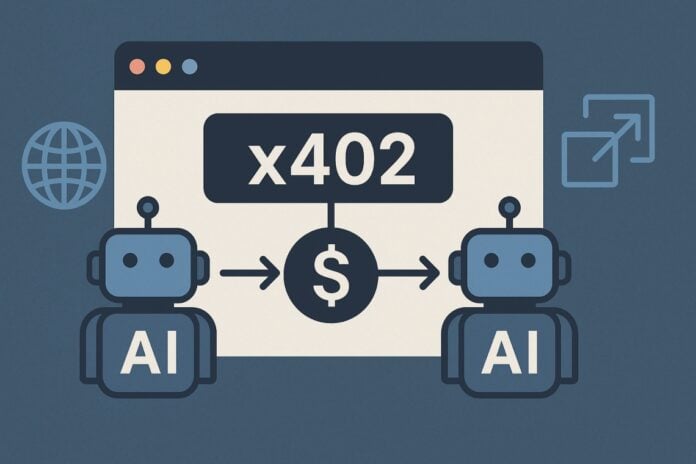HTTP 402 evolves from a simple error message to a payment lane: x402 aims to unlock billions of automatic microtransactions between AI agents and web services, ensuring low latency and native flows for APIs.
The project was announced by Cloudflare and Coinbase, who have established the x402 Foundation to coordinate a universal standard that makes the HTTP 402 code “machine-readable,” enabling consumption-based payments without human intervention and paving the way for new economic models for access to data, models, and computational capabilities at web scale.
According to the data collected by the promoters during the initial tests announced in September 2025, the x402 playground allowed for end-to-end interactions in testnet with round-trip times compatible with many modern APIs, demonstrating the technical sustainability of the proposed flow Cloudflare.
Industry analysts note that standardizing the 402 code as machine-readable metadata could reduce operational costs related to manual interactions and transform non-monetized bot traffic into consumption-based revenue.
For a technical reference on the original semantics of HTTP 402, you can consult the official documentation of HTTP status MDN Web Docs.
Summary
What is x402: from “Payment Required” to machine-readable instructions
The proposal transforms the classic “Payment Required” into a set of payment metadata that an agent can interpret and fulfill autonomously.
In practice, the protocol – conceived as open – is designed to interoperate with instantaneous settlement methods (like stablecoin) or deferred ones (cards, bank transfers – with AML/KYC requirements and regulations currently under discussion).
The 4-step flow (simplified)
- Offer: the server responds with HTTP 402 including amount, currency/method, and endpoint for payment when an agent requests protected content.
- Authorization: the agent repeats the request including a “payment authorization header” (signed token or proof of balance).
- Regulation: a “facilitator” (payment provider or gateway) verifies, charges, and confirms the transaction.
- Delivery: upon payment, the server returns the requested content, accompanied by a verifiable receipt.
The authorization header is an HTTP header demonstrating payment capability; the facilitator is the operator who performs verification, collection, and reporting, and can also be the site provider.
Why it is relevant for web payments
x402 overcomes the bottleneck created by human interactions (form, captcha, sessions) and enables repeated microtransactions between agents and APIs, with control over pricing, limits, and access to resources.
In this context, for those managing content and services, it becomes possible to transform bot traffic into consumption-based revenue; for developers, a programmable and traceable monetization channel opens up.
Market Data and Context
- Over 1 billion: it is estimated that over one billion HTTP 402 errors are sent daily to bots attempting to access content, as reported by promoters (Cloudflare).
- 70%: according to a recent article, in 2024, 70% of stablecoin transfers were attributed to bots.
- Stablecoin market: the capitalization, which was around 4 billion USD in 2020, has exceeded 280 billion USD, with on-chain settlement volumes reaching approximately 1.39 trillion USD/month in the first six months of 2025, data updated to September 2025 (Yahoo Finance). Additionally, some analysts indicate that stablecoin issuers currently rank 17th in holdings of US Treasury securities (data under verification).
These numbers, updated to September 2025, highlight how the demand for programmable money for agents and APIs is already significant and growing.
Technical Integration and Use Cases
Cloudflare has introduced an x402 playground that allows experimentation with instant payments in USDC on Base in a testnet environment.
To manage payments in the cloud domain, AWS is reportedly evaluating the integration of consumption-based billing (information to be verified), while platforms like Pinata and Heurist are experimenting with pay-per-file and pay-per-query models.
Additionally, Coinbase presents x402 Bazaar, founded by Sean Neville, has announced funding of 18 million USD to develop enabling components for AI-native infrastructures.
The model supports both instant payments via stablecoin and deferred solutions (such as cards or bank accounts) while maintaining a unique semantics applicable to the API.
Project Status: specifications, testing, adoption
- Spec: the proposal is currently being prepared through whitepaper and RFC. The release of a GitHub repository containing formats for headers, signature schema, and error messages is pending.
- Test: the x402 playground on the testnet is active and allows for experimenting with the end-to-end flow.
- Adoption: the initial partners are involved in a pilot, while the timeline for the production launch is being defined.
Impact for companies and developers
The new protocol opens innovative economic scenarios for data, content, and computational capabilities:
- Pay-per-request: payment on API and datasets updated in real-time.
- Dynamic pricing: prices that vary based on priority, volume, or quality of service.
- Pay-as-you-go access: payment method for model inference, ethical scraping, and research tools.
For developers, the integration of automatic payments between agents and suppliers will be simplified, with management of quotas, rate limiting, and verifiable receipts.
Risks and Limitations
- Compliance: AML/KYC requirements for facilitators and merchants and the different regulatory approaches for stablecoins, cards, and transfers are still under discussion (Standard Chartered and FalconX).
- Fraud and abuse: cryptographic proofs, spending limits, revocation capabilities, and protection systems against hostile automation are necessary.
- Operating costs: network/on-chain fees, disputes, and chargebacks in traditional payments represent challenges.
- Privacy: it is essential to minimize the data processed in payment metadata and logs to avoid correlations that could compromise privacy.
- Latency: instant payments can introduce delays, while the deferred payment method, although reducing overhead, requires trust and careful risk management.
Minimum Example of Request x402
Below is an indicative header scheme (not to be used in production without the approval of the official spec):
GET /resource HTTP/1.1
Host: api.example.com
Accept: application/json
X-402-Payment: method=stablecoin; amount=0.002; asset=USDC; chain=Base
Authorization: X402 signature=”base64…”, facilitator=”pay.example”, nonce=”…”
The server, responding with a 402 error containing price, method, and preferred facilitator, allows the agent to repeat the request by including valid Authorization, thus completing the payment process.
Quotes and Positions
According to Brian Armstrong, CEO of Coinbase, in a post on X dated September 23, 2025 (source Coinbase), “AI agents can now transact value, not just exchange info.” This statement summarizes the shift from a data exchange to a native value exchange, capable of radically transforming the way transactions occur on the web.
Essential Timeline
- Announcement: September 2025.
- Spec: public draft in progress, with revisions expected soon (Coinbase x402 Bazaar).
- Pilots: experimental integrations underway with selected partners.
Resources for further exploration
- Official Cloudflare Blog (announcement and technical details).
- Official Coinbase Blog (context payments and stablecoin).
- GitHub repository of the x402 Foundation (spec, examples, playground) – coming soon.
- Post on X by Brian Armstrong on 09/23/2025.
Conclusion
x402 proposes a shared semantics for machine payments on the web, enabling consumption-based monetization of content, data, and computational resources. If adoption grows, the protocol could strengthen the role of stablecoin as a settlement medium for AI agents, redesigning the API economy with native payments.


